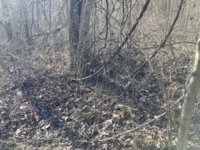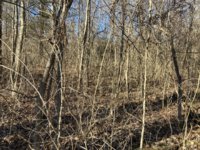It likely won't carry a fire if it looks like what my mind tells me it does from experience of what your describing. Even if it did, that in itself can be a very large task if your not experienced in RX burns in Ohio. On top of that you still will need herbicide treatment even after a fire. A mulcher is an option but I've found many guys that mulch are either dishonest or uneducated in plant biology. They always label it as invasive species removal when in fact the invasive will grow back 5x the density pre-mulching if due diligence isn't taken via herbicide at some point. It sure looks nice for a few months though once they finish!
I've worked in multiple invasive thickets just like you are describing and unfortunately there is no quick or easy answer. Its a hell of a lot of work to do it the correct way, and there are no shortcuts. I think you have 3 options in your scenario.
1) Cut and stump treat. This can be done year round if need be, but ideal time is from August through March to avoid upwards sap flow during peak growing season. Cut with chainsaw, brush saw or any other handheld method and treat stumps immediately after cutting. I use a 14 inch arborist saw in one hand and a 3 pint sprayer in the other. This is a slow, tedious method and the biggest expense is man power. The results are great as you are 100% selective in what you cut, and can save any desirable trees. Leave cut invasives where they lay. They provide good brush piles for wildlife and not worth the effort to drag them out, which takes between 2x and 4x the time it took to cut them. They will rot down in short order as invasives rot quickly. Its not like cutting an oak and leaving it lay there for 20 years.
2) Foliar treatment. This one has a small time window. The key is to spray once most native vegetation has lost its leaves, yet the invasive are still holding theirs. This will take place between mid October all the way up to December on some years, though typically the window is over mid November. This is also an excellent time to foliar spray as the plants are actively taking down nutrients to store in their roots for winter. Bush Honeysuckle is particularly vulnerable. Its almost unfair


. You spray all the leaves of the target species. You try not to overspray but if you are doing it during the proper time frame its not typically an issue, and is usually unavoidable for some over spray. I prefer this method to cut and treat as I can cover ground much quicker and be more efficient. The results are pretty amazing too. I also have a $25k rig that I built specifically for this purpose so I'm probably biased, but its my favorite method by far for these cases. Targeted vegetation will be dead skeleton the coming spring, and will eventually fall over and rot. Positives are quicker work and a better result. Negatives are a massive amount of chemical use, which also means more chemical expenses.
3) Forestry Mulcher. Be prepared for multiple foliar herbicide applications the following years. You still will have a live and intact root system that will be trying to over- compensate to survive and the shoots off the roots will be crazy. Positives are a "clean " looking site (if you consider that a positive) as well as a much quicker job. Negatives are you will need multiple herbicide applications to keep it that way. Also negative is you will usually lose all native vegetation that is the same size class. That forestry head doesn't discriminate between an Olive and an Oak.
None of the 3 methods are cheap and none are easy. Chemcials need to be the right chemical for the right application. I wouldn't let up on that EQIP grant, even if it only pays 30%. That could equal thousands of dollars. Plan for a multiple year process. Tell NRCS you want multiple years of treatment built into your contract. I've worked on contracts with as many as 3 years, and those are the best written contracts. Even when everything is done right you will have multiple years of treatment. Think of all the seeds waiting to sprout as well, some of which can sit dormant in the soil for 25 years.
Its not an easy task and can be overwhelming. I find it an absolutely worthy task though, and healing your land is step one in creating your wildlife oasis.
BTW thanks for reaching out previously. Really wish I was closer to help. These projects take so much time and I just can't take anything else on right now.



